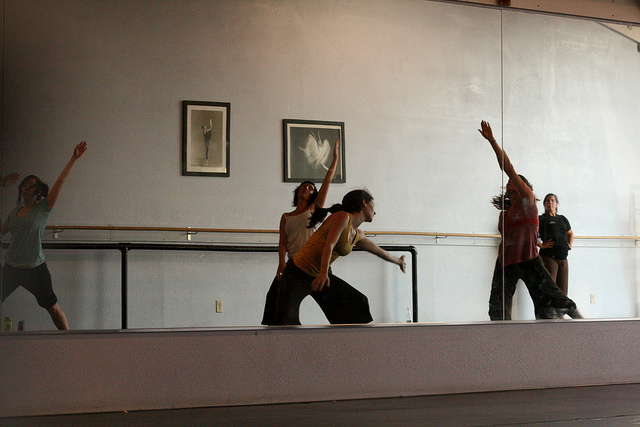
We all know the saying “if you can teach it then you know you know it.” I often have my students teach or help each other with movement they are learning in class to empower them and allow them time to know they know the material without constantly watching me demonstrate. One of my favorite assignments is when I have my students create and teach and full lesson plan to the whole class.
I put my students into pairs and they pick a theme for their lesson. Some theme examples are: movement initiated from certain body parts, extremes in timing or playing with rhythms, and moving into and out of the floor with smooth transitions. Once my students pick their theme they start to create a movement phrase that demonstrates their theme. They also have to create movement that travels across the floor and a warm up, all of which must be centered on their chosen theme.
Students must type up a full lesson plan including music selections, movement sequences written out, and how much time they plan to spend teaching and doing each section of class. This helps them to determine the length and how much movement they need to create for each section as well. For example, warm up will take 8 minutes, across the floor 10 minutes, and center phrase 15 minutes.
Overall I find that my students are very successful when it comes to the creativity and creation of movement sequences for a warm up, across the floor, and a center phrase. They understand their theme and how to make movement based on it. The difficult part usually comes when they practice teaching each other and they don’t cue with their words the way in which they want the dancers to do the movement. Students tend to focus on steps and coordination rather than how they are performing the movement. They want to focus on saying steps like move your right foot then left arm over here, but they forget to describe how those movements should occur or with what kind of focus and intention they should be performed.
In coaching them on this aspect of teaching I talk with them about using more descriptive words. For example, we talk about the difference between telling students to raise their right arm with tension or raise their right arm leading from the finger tips, or just raise your arm. When students create analogies and metaphors for their movement to help their students perform the desired movement they see better results. When students are asked to articulate exactly how they want the dancers to do their movement it challenges them to think about their movement more deeply and the way in which they are moving their own bodies. Another of teaching is to watch their students and analyze if they are doing the movement the way they want them to. As the teachers, they have to give both positive feedback and corrections to the class about what they see them doing.

When my students have to shift their focus on movement from steps to quality of movement as the teacher this can help them shift their focus when they are the student as well. They can begin to see and feel movement in a deeper way within their own body. This can create a new pathway for students to become stronger performers and better movers in their bodies.
We also talk about being flexible with their pacing of the class and how much movement they teach. The goal is not to teach everything they create but rather for the students to demonstrate their theme through the performed movement. So this might mean that they have to shorten their phrase if the students are not demonstrating the movement properly. It is more important that the students perform the movement well rather than learn a lot of movement but not perform it well. This can be challenging for the new teachers since they have to time manage the class in the moment.
Some other elements we focus on are speaking loud enough for the class to hear them and presenting movement with confidence. I usually assign this project during second semester so that by this point the students are more comfortable with one another and have already taken risks in front of each other. This helps to create a supportive learning environment. Having the students teach with a partner also helps lighten the pressure on individuals because it becomes more of a team effort.
I hope that the things my students take away from this lesson can translate into other classes they take or areas of their life. There are so many benefits to teaching students how to teach movement that I hope maybe you are inspired to create your own teaching dance lesson for your students!

Contributor Janet Rothwell has been a dance educator for 10 years. She has taught modern, ballet, and jazz at various studios and schools on Chicago’s North Shore. She received her MA in Dance with an emphasis in Choreography from the University of North Carolina-Greensboro and her BA in Communications with a Dance Minor from the University of Wisconsin-Madison. Throughout her time in graduate school, Janet performed with Sidelong Dance Company based in Winston-Salem, NC.
Currently, Janet teaches dance at Loyola Academy High School in Wilmette, IL. She is the Director of Loyola Academy Dance Company B and the Brother Small Arts Guild, and choreographs for the Spring Dance Concert and school musical each year. Janet is very active within the Loyola Academy community leading student retreats and summer service trips. She regularly seeks out professional development opportunities to continue her own artistic growth. Recently, Janet performed with Keigwin and Company in the Chicago Dancing Festival 2012 and attended the Bates Dance Festival.
When she isn’t dancing, Janet enjoys teaching Pilates, practicing yoga, and running races around the city of Chicago.




